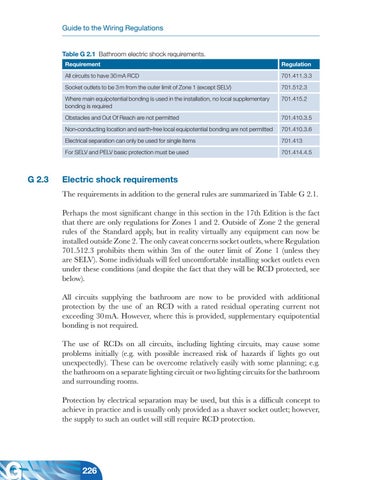Guide to the Wiring Regulations
Table G 2.1 Bathroom electric shock requirements.
G 2.3
Requirement
Regulation
All circuits to have 30 mA RCD
701.411.3.3
Socket outlets to be 3 m from the outer limit of Zone 1 (except SELV)
701.512.3
Where main equipotential bonding is used in the installation, no local supplementary bonding is required
701.415.2
Obstacles and Out Of Reach are not permitted
701.410.3.5
Non-conducting location and earth-free local equipotential bonding are not permitted
701.410.3.6
Electrical separation can only be used for single items
701.413
For SELV and PELV basic protection must be used
701.414.4.5
Electric shock requirements The requirements in addition to the general rules are summarized in Table G 2.1. Perhaps the most significant change in this section in the 17th Edition is the fact that there are only regulations for Zones 1 and 2. Outside of Zone 2 the general rules of the Standard apply, but in reality virtually any equipment can now be installed outside Zone 2. The only caveat concerns socket outlets, where Regulation 701.512.3 prohibits them within 3m of the outer limit of Zone 1 (unless they are SELV). Some individuals will feel uncomfortable installing socket outlets even under these conditions (and despite the fact that they will be RCD protected, see below). All circuits supplying the bathroom are now to be provided with additional protection by the use of an RCD with a rated residual operating current not exceeding 30 mA. However, where this is provided, supplementary equipotential bonding is not required. The use of RCDs on all circuits, including lighting circuits, may cause some problems initially (e.g. with possible increased risk of hazards if lights go out unexpectedly). These can be overcome relatively easily with some planning; e.g. the bathroom on a separate lighting circuit or two lighting circuits for the bathroom and surrounding rooms. Protection by electrical separation may be used, but this is a difficult concept to achieve in practice and is usually only provided as a shaver socket outlet; however, the supply to such an outlet will still require RCD protection.
G
226
